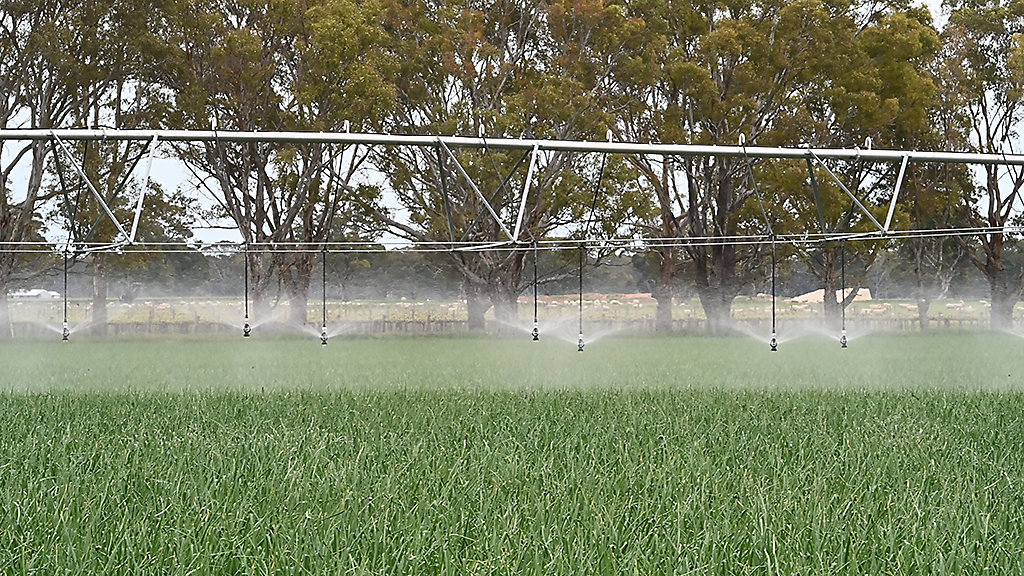Australia
March 1, 2023
Wet weather and the onset of Downy mildew are major challenges for agronomist Shane Ebert on onion crops in the south-east region of South Australia.
Mr Ebert was standing in a crop of onions, in early October, following a week of wet weather and contemplating a forecast for a lot more.
“This crop was planted in late April, and it went through a very wet winter,” he said. “We’ve been pulling it out of those wet conditions and getting it through the wet spring.”
He said the crop had a lot of canopy at that time of year so was at risk of Downy mildew.
 Agronomist, Shane Ebert uses Zorvec® Enicade® to keep onions clean of Downy mildew on farms in the south-east of South Australia.
Agronomist, Shane Ebert uses Zorvec® Enicade® to keep onions clean of Downy mildew on farms in the south-east of South Australia.
“We run a heavy, robust preventative programme and when we see weather like last week, it’s exactly the right time for Zorvec®.”
Zorvec® Enicade®, from Corteva Agriscience, is a robust Downy mildew product for onions and many other horticultural crops.
“I will always start off with an Acrobat® type product,” Mr Ebert said. “They used to be the best you could buy, and they are still good, but then I rotate out with Zorvec.”
“Zorvec would be my product of choice. It's just got a bit of sting about it. I saw that weather coming last Monday and then this week, it's had a Zorvec.”
“This looks like a Zorvec year because I'm hearing about Downy mildew. I haven't seen it here. We've been onto it, but apparently it's further north and probably heading down to our district."
He said the crop had to grow through until mid-December, so if Downy mildew did show up in October it was a long time through to harvest.
“You probably won't hold it.”
“In the early stages of the season the preventative program included Acrobat, Dithane, copper and metalaxyl and then rotated through to Zorvec as the crop bulked up and the wet weather set in.”
Mr Ebert said the bulkier crop meant it was more challenging to get product down into the canopy so they would always change the spray configuration to suit.
“As soon as I get onto something like Zorvec, we always swap our nozzle patterns around,” he said.
 Onions in the south-east of South Australia are susceptible to Downy mildew during times of high rainfall and high humidity.
Onions in the south-east of South Australia are susceptible to Downy mildew during times of high rainfall and high humidity.
“We go with 45-degree angles so we're coating the canopy from the front and behind and double our water rates to 500 litres per hectare. We need as much activity out of it as possible.”
He said times of the year with rain, humidity and warmer temperatures are suited to Downy mildew, so Zorvec is the preferred option in the spring and early summer.
The Downy mildew program includes a wide range of fungicide options with different modes of action to reduce the risk of resistance.
“There's so many things that have resistance now,” Mr Ebert said. “I just don't want to be dealing with it with something like Downy mildew.”
“Ryegrass has been a great lesson. As soon as you start hammering any one thing, it will be a major problem. We just rotate - it's just part of the programme.”
Onions in the area are planted from April through to September, with harvest timed with the packing shed requirements.
“It's all strategically planted time wise, and the varieties are all chosen to either be storage or a quick sale onion," Mr Ebert said.
“Onions that go into cool storage have a very different fungicide programme, late compared to an onion that will be first to market.”
He said onions were a challenging crop to grow but worked well when they had everything in place.
“It's all the years leading up to it, but when you get it right, it's quite rewarding. There's not too often you can take many shortcuts with onions."
Acrobat is a registered trademark of BASF